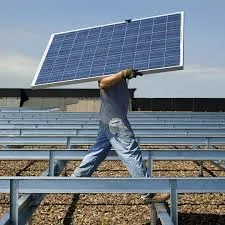Cost Analysis of 300kW Solar Panel Installation for Optimal Investment
The Cost of 300 kW Solar Panels A Comprehensive Overview
The transition towards renewable energy has gained remarkable momentum in recent years, and solar power stands at the forefront of this shift. Among various solar power systems, the 300 kW solar panel setup has emerged as a popular choice for commercial and large residential applications. Understanding the cost associated with a 300 kW solar panel installation is crucial for businesses and homeowners looking to invest in solar energy. This article will provide an in-depth analysis of the costs involved, factors influencing pricing, and the long-term financial benefits of solar energy.
Upfront Costs of 300 kW Solar Panels
The initial cost of a 300 kW solar panel system can vary significantly based on several factors, including location, installation complexity, panel type, and local market conditions. On average, the cost of installing a 300 kW solar power system can range from $300,000 to $600,000 before any incentives or rebates. This estimate includes solar panels, inverters, mounting systems, and installation labor.
1. Solar Panels The type of solar panels chosen will have a significant impact on the overall cost. There are generally three types of solar panels available monocrystalline, polycrystalline, and thin-film. Monocrystalline panels are often the most expensive but offer higher efficiency and better performance in limited space. Polycrystalline panels are more affordable but have slightly lower efficiency. Thin-film panels, while cheaper, occupy more space and typically have lower efficiency ratings.
2. Inverters Inverters convert the direct current (DC) generated by solar panels into alternating current (AC) used in homes and businesses. The type and brand of inverters can influence the overall cost. Advanced microinverters and string inverters may have different price ranges, affecting installation costs as well.
3. Installation Costs Labor costs can vary widely based on geographic location and the complexity of the installation. It is essential to hire qualified and experienced installers to ensure the system functions efficiently and adheres to local regulations.
4. Permitting and Other Fees Obtaining the necessary permits and meeting local regulations may incur additional costs. This can include inspection fees, connection fees, and other administrative charges that vary by location.
Factors Influencing Solar Panel Costs
1. Geographical Location The cost of solar panel installation can differ based on the region due to varying labor costs, climate conditions, and local regulations. States with strong solar incentives, such as California and New York, may have different cost structures compared to regions with less solar installation activity.
300kw solar panel cost

2. State and Federal Incentives Solar panel installation costs can be significantly offset by various federal, state, and local incentives. These could include tax credits, rebates, and grants. For example, the federal Investment Tax Credit (ITC) allows property owners to deduct a percentage of the installation costs from their federal taxes.
3. Economies of Scale Larger installations often benefit from economies of scale, leading to a lower cost per watt. Investing in a larger system like a 300 kW setup often results in a reduced cost per watt compared to smaller installations.
Long-term Financial Benefits
Investing in a 300 kW solar panel system can lead to significant long-term savings. Here are some of the key financial benefits
1. Reduction in Electricity Bills By generating your own electricity, businesses can significantly reduce their energy bills. This is particularly beneficial during peak electricity hours when power rates tend to be higher.
2. Return on Investment (ROI) The ROI for solar installations can vary, but many businesses experience payback periods ranging from five to ten years. After recouping the initial investment, businesses can enjoy free electricity for the remaining lifespan of the system, typically 25 years or more.
3. Increased Property Value Solar panel installations can enhance the value of a property. According to various studies, homes and businesses equipped with solar energy systems often sell for a premium compared to those without.
4. Sustainability and Corporate Responsibility Transitioning to solar energy not only reduces operating costs but also showcases a commitment to sustainability. Businesses that adopt eco-friendly practices may find favorable responses from consumers who prioritize corporate responsibility.
Conclusion
While the upfront costs of a 300 kW solar panel system can appear significant, the long-term benefits far outweigh these initial expenses. With various financing options, incentives, and the decreasing costs of solar technology, businesses can secure a sustainable and financially beneficial energy source. Investing in solar energy represents not just a step towards environmental stewardship but also a smart financial decision in an increasingly energy-conscious world.
-
String Solar Inverter: The High-Efficiency Solution for Smart Solar EnergyNewsJul.14,2025
-
Revolutionizing Rooftop Energy with the Power of the Micro Solar InverterNewsJul.14,2025
-
Power Independence with Smart Off Grid Solar Inverter SolutionsNewsJul.14,2025
-
On Grid Solar Inverter: Powering the Future with Smart Grid IntegrationNewsJul.14,2025
-
Monocrystalline Solar Panels: High-Efficiency Power for the Future of Clean EnergyNewsJul.14,2025
-
Bifacial Solar Panel: A Smarter Investment for Next-Generation Energy SystemsNewsJul.14,2025







